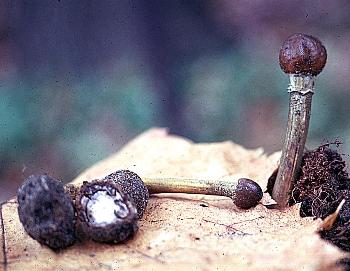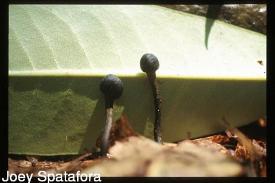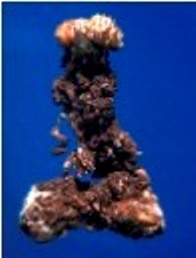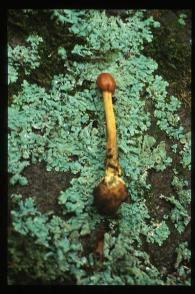Relatives
Who else is in the Cordyceps genus?
There are many, many different species that are in the Cordyceps genus! Here are just a few of them! To help explain better the differences between these species, a phylogenetic tree can be found here.
This phylogenetic tree is about some of the members of the genus Elaphocordyceps. The phylogeny is based off of molecular data. To determine the DNA sequence, five different genes were used. These genes include nuclear ribosomal small (nrSSU), nuclear ribosomal large subunits (nrLSU), elongation 1 α (tef1), largest subunits of RNA Polymerase II (rpb1), and second largest subunits of RNA Polymerase II (rpb2). To help explain more about them, pictures and descriptions will be provided below this tree.
Elaphocordyceps capitata
 E. capitata is also considered (by Sung and others) to be
Elaphocordyceps capitata, which is in the same genus as E.
subessilis. By being in this genus, it means that this fungus likes to
parasitize members of the Elaphomyces. The stipe is cylindrical
and directly connected to the host. Its perithecia is ovoid and has
cylindrical asci with ascospores that are also cylindrical, multiseptate, and
break into part-spores.
E. capitata is also considered (by Sung and others) to be
Elaphocordyceps capitata, which is in the same genus as E.
subessilis. By being in this genus, it means that this fungus likes to
parasitize members of the Elaphomyces. The stipe is cylindrical
and directly connected to the host. Its perithecia is ovoid and has
cylindrical asci with ascospores that are also cylindrical, multiseptate, and
break into part-spores.
Elaphocordyceps longisegmentis
E. longisegmentis is also a member of the Elaphocordyceps just like the rest of the fungi in the phylogenetic tree. This fungus is a parasite of the Elaphomyces genus. It has only one stroma and a relatively larger fertile region compared to the stipe. The ascospores are filamentous and separate into partspores. The perithecia is ellipsoid (elliptical shape) and buried in the surrounding tissue.
Elaphocordyceps japonica
 E.. japonica is an interesting fungus. It also parasitizes the
genus, Elaphomyces. It has branched stromata, a cylindrical stipe,
oval-shaped perithecia, cylindrical asci, and
filamentous ascospores. The fertile area of E. japonica is quite
different as it is club-shaped or tube-shaped and is usually not separated from
the stipe.
E.. japonica is an interesting fungus. It also parasitizes the
genus, Elaphomyces. It has branched stromata, a cylindrical stipe,
oval-shaped perithecia, cylindrical asci, and
filamentous ascospores. The fertile area of E. japonica is quite
different as it is club-shaped or tube-shaped and is usually not separated from
the stipe.
Elaphocordyceps fracta
 E. fracta is a beautiful fungus. A lot of the characteristics are
alike to C. japonica, but it looks more like C. longisegmentis
or C. capitata. Some of its characteristics include having a
dense/clustered stromata, oval-shaped perithecia, cylindrical asci, and
ascospores that are filamentous, multiseptate, and easy to break into
part-spores.
E. fracta is a beautiful fungus. A lot of the characteristics are
alike to C. japonica, but it looks more like C. longisegmentis
or C. capitata. Some of its characteristics include having a
dense/clustered stromata, oval-shaped perithecia, cylindrical asci, and
ascospores that are filamentous, multiseptate, and easy to break into
part-spores.
Elaphocordyceps paradoxa
E. paradoxa is one of the more interesting Cordyceps species. Although it doesn't produce anything as special and important as Cyclosporine, it is intriguing. Some of its characteristics include a single, simple stromata, cylindrical asci, and perithecia that are ovoid, and buried in the surrounding tissue. Its fertile area can be either long or club-shaped. Unlike the fungi before it, it parasitizes the nymph of the cicada.
Elaphocordyceps jezoensis
This fungus is probably one of the most interesting lookers in the genus Elaphocordyceps. Some of its characteristics include having a solitary, simple stromata, a long perithecia, cylindrical asci, and ascospores that are broken up into partspores. The stalk is made up of two parts, one above and one below the ground. The above ground stalk is cylindrical and sometimes oddly curved. This organism parasitizes the Elaphomyces genus via rhizomorphs (fungal roots).
Elaphocordyceps inegoensis
Once again, we have one of the more interesting
lookers of this genus, E.
inegoensis. This organism parasitizes
cicada nymphs just like E. paradoxa. Some characteristics include
solitary, cylindrical stromata, a somewhat curved stipe, and either somewhat or
fully superficial perithecia. The fertile part is cylindrical just like
the part-spores.
Elaphocordyceps ophioglossoides
One of the most popular
Elaphocordyceps
fungi would be E. ophioglossoides. Sometimes, it can be easily found in
the woods, that is, if you look carefully enough. It has a lot of
morphological characteristics
alike to that of E. paradoxa. This
organism has several, solitary, club-shaped or cylindrical stromata that
rarely divide. Some other characteristics include a stipe that is
cylindrical, a fertile area that is club-shaped or spindle-shaped, and
perithecia that are ovoid, crowded, and buried. Its asci are cylindrical
and the ascospores are multiseptate. This fungus also parasitizes
members of the Elaphomyces genus just like the greater majority of the
Elaphocordyceps.
After looking at some members of Elaphocordyceps, lets look at other fungi that are a part of Cordyceps, in general.
Cordyceps militaris
This fungus is probably the best known out of all the Cordyceps
species and it is
not apart of the Elaphocordyceps genus, so it is not as closely related
to C. subsessilis as the other fungi are. It is found throughout the Northern hemisphere and is known for
its parasitic relationship with lepidopteran pupae. It is sometimes found
in the southern hemisphere while parasitizing other organisms like lepidopteran
or coleopteran larvae. They have cylindrical to slightly club-shaped
stromata, with ovoid perithecia that are shaped at right angles to the stipe.
If you are interested in learning about all the Cordyceps species, click here to visit a website totally devoted to Cordyceps.
Are you ready for some fun? To continue on to a Cordyceps activity, click here!
If you are done and ready to quit, click here to go home!

